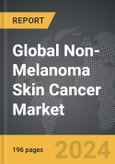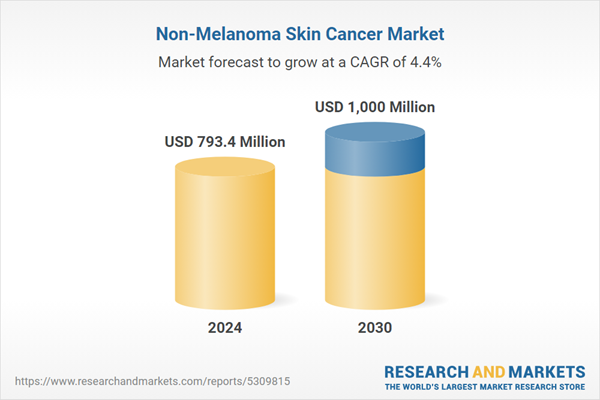Global Non-Melanoma Skin Cancer Treatment Market - Key Trends & Drivers Summarized
What Is Non-Melanoma Skin Cancer and Why Is Treatment Critical?
Non-melanoma skin cancer (NMSC) refers to a group of skin cancers that are more common but less aggressive than melanoma. The two primary types are basal cell carcinoma (BCC) and squamous cell carcinoma (SCC). NMSC primarily results from prolonged exposure to ultraviolet (UV) radiation and is often found in areas frequently exposed to the sun, such as the face, neck, and hands. Though typically less likely to spread than melanoma, non-melanoma skin cancers can cause significant tissue damage and disfigurement if not treated promptly.Treatment for non-melanoma skin cancer is critical for preventing the disease from progressing, preserving appearance, and avoiding recurrence. Various treatment options are available, including surgical removal, radiation therapy, cryotherapy, and newer, more targeted options like topical medications, photodynamic therapy (PDT), and immune checkpoint inhibitors. The availability of advanced treatments helps reduce the risk of scarring and recurrence, offering patients better cosmetic outcomes and quality of life.
How Is the Non-Melanoma Skin Cancer Treatment Market Evolving?
The non-melanoma skin cancer treatment market is evolving with the introduction of new, minimally invasive therapies. One of the key trends is the growing use of immune-based therapies, such as immune checkpoint inhibitors, which have shown efficacy in treating advanced and recurrent NMSC cases. These therapies help the immune system recognize and attack cancer cells more effectively, reducing tumor growth and recurrence rates. Additionally, topical therapies, including immune-modulating creams and photodynamic therapy (PDT), are gaining popularity as they offer non-invasive treatment options for early-stage NMSC.Another significant trend is the increasing focus on early diagnosis and treatment, supported by advancements in skin cancer screening technologies like dermatoscopy and AI-powered diagnostic tools. These technologies help detect NMSC at earlier stages, enabling less aggressive treatments and improving outcomes. As healthcare providers emphasize preventive care and early intervention, the demand for topical therapies and non-invasive treatment options is expected to grow.
Which Patient Groups Are Driving the Demand for NMSC Treatments?
The demand for non-melanoma skin cancer treatments is primarily driven by older adults, as the risk of NMSC increases with age. Individuals with a history of prolonged sun exposure, particularly those with fair skin, light hair, or a history of sunburns, are at higher risk of developing NMSC. Outdoor workers, athletes, and people living in regions with high UV exposure are also significant patient groups seeking treatment for non-melanoma skin cancers.Another important patient group includes individuals with compromised immune systems, such as organ transplant recipients and those with chronic immune conditions. These individuals are more susceptible to developing NMSC and often require more aggressive treatment due to the risk of recurrence. Additionally, patients with a history of skin cancer are more likely to experience multiple NMSC occurrences, driving demand for effective and recurrent-preventing treatments.
What Are the Key Growth Drivers in the Non-Melanoma Skin Cancer Treatment Market?
The growth in the non-melanoma skin cancer treatment market is driven by several factors, starting with the increasing incidence of skin cancer due to higher UV exposure and an aging population. The growing awareness of skin cancer prevention and the importance of early detection are also contributing to market growth, as more patients seek early treatment for precancerous lesions and early-stage NMSC. The rise in non-invasive and minimally invasive treatments, such as topical therapies and photodynamic therapy, is another critical driver, as patients and healthcare providers prioritize treatments that minimize scarring and recovery time.Advancements in immune-based therapies, particularly for advanced and recurrent NMSC cases, are further boosting demand for new treatment options. Technological innovations in diagnostic tools, which allow for earlier and more accurate detection, are supporting the trend toward early intervention and less invasive treatments. Additionally, increasing government initiatives and public health campaigns focused on skin cancer prevention and sun protection are driving market expansion.
Report Scope
The report analyzes the Non-Melanoma Skin Cancer market, presented in terms of units. The analysis covers the key segments and geographic regions outlined below.Segments: Indication (Basal Cell Carcinoma (BCC), Other Indications); Treatment Type (Radiation Therapy, Other Treatment Types).
Geographic Regions/Countries: World; United States; Canada; Japan; China; Europe (France; Germany; Italy; United Kingdom; and Rest of Europe); Asia-Pacific; Rest of World.
Key Insights:
- Market Growth: Understand the significant growth trajectory of the Basal Cell Carcinoma (BCC) segment, which is expected to reach US$835.6 Million by 2030 with a CAGR of a 4.7%. The Other Indications segment is also set to grow at 3.2% CAGR over the analysis period.
- Regional Analysis: Gain insights into the U.S. market, valued at $216.8 Million in 2024, and China, forecasted to grow at an impressive 4.1% CAGR to reach $161.4 Million by 2030. Discover growth trends in other key regions, including Japan, Canada, Germany, and the Asia-Pacific.
Why You Should Buy This Report:
- Detailed Market Analysis: Access a thorough analysis of the Global Non-Melanoma Skin Cancer Market, covering all major geographic regions and market segments.
- Competitive Insights: Get an overview of the competitive landscape, including the market presence of major players across different geographies.
- Future Trends and Drivers: Understand the key trends and drivers shaping the future of the Global Non-Melanoma Skin Cancer Market.
- Actionable Insights: Benefit from actionable insights that can help you identify new revenue opportunities and make strategic business decisions.
Key Questions Answered:
- How is the Global Non-Melanoma Skin Cancer Market expected to evolve by 2030?
- What are the main drivers and restraints affecting the market?
- Which market segments will grow the most over the forecast period?
- How will market shares for different regions and segments change by 2030?
- Who are the leading players in the market, and what are their prospects?
Report Features:
- Comprehensive Market Data: Independent analysis of annual sales and market forecasts in US$ Million from 2024 to 2030.
- In-Depth Regional Analysis: Detailed insights into key markets, including the U.S., China, Japan, Canada, Europe, Asia-Pacific, Latin America, Middle East, and Africa.
- Company Profiles: Coverage of players such as Almirall SA, Amgen, Inc., F. Hoffmann-La Roche AG, Lytix Biopharma AS, MediWound Ltd. and more.
- Complimentary Updates: Receive free report updates for one year to keep you informed of the latest market developments.
Some of the 46 companies featured in this Non-Melanoma Skin Cancer market report include:
- Almirall SA
- Amgen, Inc.
- F. Hoffmann-La Roche AG
- Lytix Biopharma AS
- MediWound Ltd.
- Merck & Co., Inc.
- OncoBeta GmbH
- Philogen S.p.A.
- Premium Europe
- Regeneron Pharmaceuticals, Inc.
Tariff Impact Analysis: Key Insights for 2025
Global tariff negotiations across 180+ countries are reshaping supply chains, costs, and competitiveness. This report reflects the latest developments as of April 2025 and incorporates forward-looking insights into the market outlook.The analysts continuously track trade developments worldwide, drawing insights from leading global economists and over 200 industry and policy institutions, including think tanks, trade organizations, and national economic advisory bodies. This intelligence is integrated into forecasting models to provide timely, data-driven analysis of emerging risks and opportunities.
What’s Included in This Edition:
- Tariff-adjusted market forecasts by region and segment
- Analysis of cost and supply chain implications by sourcing and trade exposure
- Strategic insights into geographic shifts
Buyers receive a free July 2025 update with:
- Finalized tariff impacts and new trade agreement effects
- Updated projections reflecting global sourcing and cost shifts
- Expanded country-specific coverage across the industry
Table of Contents
Companies Mentioned (Partial List)
A selection of companies mentioned in this report includes, but is not limited to:
- Almirall SA
- Amgen, Inc.
- F. Hoffmann-La Roche AG
- Lytix Biopharma AS
- MediWound Ltd.
- Merck & Co., Inc.
- OncoBeta GmbH
- Philogen S.p.A.
- Premium Europe
- Regeneron Pharmaceuticals, Inc.
Table Information
| Report Attribute | Details |
|---|---|
| No. of Pages | 196 |
| Published | April 2025 |
| Forecast Period | 2024 - 2030 |
| Estimated Market Value ( USD | $ 793.4 Million |
| Forecasted Market Value ( USD | $ 1000 Million |
| Compound Annual Growth Rate | 4.4% |
| Regions Covered | Global |









